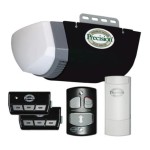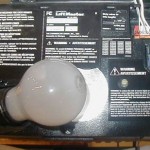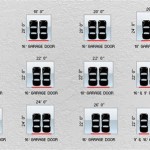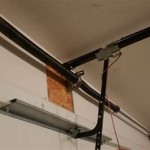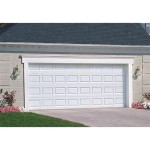How To Fix a Garage Door Gap
A garage door gap, the space between the bottom of the garage door and the floor, can be a source of frustration for homeowners. It allows entry for pests, exposes the garage to the elements, compromises energy efficiency, and can even pose a security risk. Diagnosing the cause of the gap is the first step in determining the appropriate solution. This article provides a comprehensive guide to identifying and addressing common causes of garage door gaps, offering practical steps for effective repair.
Several factors can contribute to the formation of a garage door gap. These factors range from simple wear and tear to more complex issues with the door's alignment or the garage floor itself. A thorough inspection will help pinpoint the root cause and inform the chosen repair method. Ignoring the gap can lead to further damage and increased repair costs in the long run.
Regular maintenance and preventative measures are essential for minimizing the likelihood of garage door gaps. These actions can include routine inspections, lubrication of moving parts, and timely replacement of worn components. By proactively addressing potential issues, property owners can protect their investment and maintain the functionality of their garage door.
Identifying the Cause of the Garage Door Gap
Before attempting any repairs, it is crucial to identify the underlying cause of the garage door gap. This involves a careful inspection of the door, its components, and the surrounding area. Common culprits include a damaged or worn-out bottom seal, an uneven garage floor, misaligned tracks, or a faulty door opener.
The bottom seal, typically made of rubber or vinyl, is designed to create a tight barrier between the door and the floor. Over time, this seal can become brittle, cracked, or torn due to exposure to the elements and repeated contact with the floor. Inspect the seal for any signs of damage, paying particular attention to areas where the gap is most prominent. A clear indication of a damaged seal is visible degradation or pieces missing from the material.
An uneven garage floor is another common cause of garage door gaps. Concrete floors can settle or crack over time, creating dips or rises that prevent the door from sealing properly. To check for unevenness, use a level and a straight edge long enough to span the width of the doorway. Place the straight edge on the floor and use the level to determine if there are any significant variations in height. A noticeable difference in height indicates an uneven floor.
Misaligned tracks can also prevent the garage door from closing flush with the floor. The tracks guide the door as it moves up and down, and if they are bent, loose, or improperly positioned, the door may not seal correctly. Inspect the tracks for any signs of damage or misalignment. Ensure they are securely fastened to the wall and that the rollers are moving smoothly within the tracks. A visual inspection should easily identify any major bends or deviations from a straight line.
A faulty garage door opener can also contribute to the problem. The opener controls the travel limits of the door, and if these limits are not set correctly, the door may not close all the way. Check the opener's settings and adjust the travel limits according to the manufacturer's instructions. This usually involves using the designated up and down adjustment screws located on the opener unit. Consult the owner’s manual for specific instructions relevant to the model.
Replacing the Bottom Seal
If the bottom seal is identified as the primary cause of the garage door gap, replacing it is usually a straightforward solution. The replacement process involves removing the old seal, preparing the surface, and installing the new seal. It is essential to choose a replacement seal that is compatible with the garage door model and track system.
Begin by removing the old seal. Depending on the type of seal, this may involve sliding it out of the track or using a screwdriver or pliers to detach it. If the seal is particularly stubborn, a utility knife can be used to carefully cut it into smaller pieces for easier removal. Exercise caution when using a utility knife to avoid injury or damage to the door.
Once the old seal is removed, clean the track thoroughly to remove any debris or residue. Use a wire brush or scraper to remove any rust or build-up. This will ensure that the new seal fits snugly and creates a proper seal. Wipe the track clean with a damp cloth and allow it to dry completely before proceeding.
Next, prepare the new seal for installation. Measure the width of the garage door and cut the new seal to the appropriate length. It is generally advisable to cut the seal slightly longer than needed to allow for trimming after installation. Ensure the cut is clean and straight for optimal performance.
Install the new seal by sliding it into the track. Depending on the type of seal, this may require lubrication with silicone spray to facilitate smooth insertion. Ensure the seal is properly aligned and seated in the track. Once the seal is fully installed, trim any excess material with a utility knife to achieve a clean, finished look. Test the door to ensure it closes fully and seals properly against the floor.
Addressing an Uneven Garage Floor
If an uneven garage floor is the source of the gap, addressing it may require more extensive repairs. There are several options available, ranging from applying a self-leveling compound to installing a threshold seal. The best approach depends on the severity of the unevenness and the budget for the repair.
For minor unevenness, a self-leveling concrete compound can be used to create a smooth, even surface. This compound is poured onto the floor and spreads out to fill in any dips or cracks. It is important to follow the manufacturer's instructions carefully when applying the compound. The area must be thoroughly cleaned and prepared before application. Allow the compound to cure completely before using the garage door.
Another option is to install a threshold seal. A threshold seal is a rubber or vinyl strip that is attached to the floor directly behind the garage door. It creates a raised barrier that compensates for minor unevenness and helps to seal the gap. Threshold seals are available in various sizes and shapes to accommodate different types of gaps. Installation typically involves using adhesive or fasteners to secure the seal to the floor.
For more significant unevenness, it may be necessary to consult with a concrete contractor to discuss options for repairing or replacing the garage floor. This may involve patching the floor with concrete or resurfacing the entire area. These options are more costly and time-consuming but provide a more permanent solution. A professional assessment will determine the most suitable repair method based on the condition of the floor.
Regardless of the chosen method, it is important to ensure that the repair is properly executed to create a smooth, even surface that allows the garage door to seal correctly. A level surface will not only eliminate the gap but also prevent future issues with the door's operation.
Adjusting Track Alignment and Door Opener Settings
When misaligned tracks or faulty door opener settings are contributing to the garage door gap, addressing these issues can often resolve the problem. This involves inspecting the tracks for proper alignment, tightening any loose fasteners, and adjusting the door opener's travel limits. It is crucial to follow the manufacturer's instructions for the specific model of garage door and opener.
Start by inspecting the tracks for proper alignment. Use a level to ensure that the tracks are vertical and parallel to each other. If the tracks are bent or loose, use a hammer and a block of wood to gently straighten them. Tighten any loose fasteners with a wrench or screwdriver. Ensure the tracks are securely attached to the wall and that the rollers are moving smoothly within the tracks. A visual inspection should easily identify any major bends or deviations from a straight line.
Next, check the door opener's travel limits. The travel limits determine how far the door opens and closes. If the limits are not set correctly, the door may not close completely, leaving a gap at the bottom. Consult the owner's manual for instructions on how to adjust the travel limits. Typically, this involves using the designated up and down adjustment screws located on the opener unit.
Adjust the down travel limit until the door closes completely and seals properly against the floor. Be careful not to set the limit too low, as this could put undue stress on the door and opener. Once the travel limits are adjusted, test the door several times to ensure it is operating smoothly and sealing correctly. Fine-tune the adjustments as needed to achieve optimal performance.
If the garage door opener is equipped with safety sensors, ensure they are properly aligned and functioning correctly. The safety sensors prevent the door from closing if there is an obstruction in its path. If the sensors are misaligned, the door may not close completely, resulting in a gap. Adjust the sensors until they are properly aligned and the door closes without any issues. Regular maintenance and cleaning of the safety sensors can prevent future problems.

How To Fix Bottom Garage Door Gap

How To Fix Garage Door Gap Travel Adjustment Youtube

Foundation Fixing Gap Under One Side Of A Steel Garage Door Home Improvement Stack Exchange

How To Fix Air Gaps On Your Garage Door

How To Fill The Garage Door Gap Bunnings Workshop Community

Fix The Gap At Bottom Of Your Garage Door Spectrum Ohd

How To Fix Gaps On Sides And Top Bottom Learn Ocgd Blog

How To Adjust Garage Door Gap Quick Fix You Need Today

Fixing The Gap At Top Of Garage Door 8 Easy Diy Solutions
New House Garage Door Does Not Seal At The Floornew Floor

